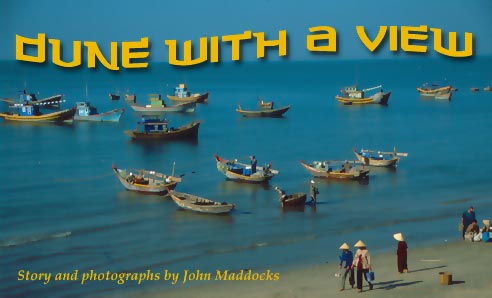|
|
Ten metres before we reach the crashing breakers, the jeep swerves and heads along the wet sand, neatly dodging the water washing up onto the shore. But I didn't understand why no-one had told me that the only way to get to the spectacular sand dunes north of Mui Ne was to go along the beach. According to the map, the dunes are situated 5 kilometres inland. So when the driver charged off the road towards the beach, I thought he'd gone crazy. "Some people find travelling on the beach a little rough," our guide Tuan shouts above the roar of engine, wind and surf. "But I am sure you will find the sand dunes and lake very interesting." Reassured, I release my white-knuckled grip on the dashboard and focus on the exhilarating side of beach bashing. I later discover that this was the part of the trip described sedately in the tour brochure as "a drive along Hon Nghe Bay." Hon Nghe is one of a series of beautiful bays near the low-key beach resort of Mui Ne, which is 200 kilometres north-east of Ho Chi Minh City. After another 10 exciting kilometres, we reach a remote fishing village at the far end of the bay. The colourful fleet of local fishing boats had been pulled onto the shore some hours earlier, and the fishermen and their families are busy checking nets and examining the day's catch. They look up in amusement as our jeep drives past. As we pull into Hon Nghe's only beach restaurant, small children shouting 'Hello' run out to meet us. There are no hawkers in this isolated spot, just some villagers passing the time of day. The owner welcomes us warmly and, still surrounded by kids, we take our place at a table that has a wonderful view of the bay. The food turns out to be exceptional. The speciality is a calamari salad with tomato, coriander and garlic dressed in a delicious light fish sauce. This part of the coast is renowned throughout Vietnam for its nuoc mam, or fish sauce. It is a 15 minute drive inland to the sand dunes. At their base is a bright blue stretch of water which for some reason is called White Lake. The blue water offsets the yellow sand perfectly. From the road the dunes look big enough, but when you start to climb them you feel like you're in the desert. And the wind carves impressive patterns that give the sand a sculpted appearance. "My father is a photographer and he has spent many hours here trying to take the ideal picture," Tuan says as he points out some wave-like effects made by the wind. Tuan's father is not alone, as there are myriad photos of the place in Vietnamese travel books. Despite this, few tourists seem to come here. After an hour walking through this bizarre landscape, Tuan announces that it's time to leave. "We must return before the tide prevents us," he says solemnly. "The waves will already be well advanced." The jeep leaves the beach and ploughs through the steep sand hills to join the road back to our resort. On the way we stop at the picturesque Mui Ne harbour, then follow the winding palm lined road through villages of thatch-roofed huts. Back at the resort - a group of free-standing cabins set in a spacious palm grove metres from the pristine Mui Ne beach - some tourists are lying by the pool in exactly the same positions they occupied when we left that morning. They don't know what they have missed. Story and photographs
by John Maddocks
|
||||||

 At
that point I understand why the driver took meticulous care to ensure
that my seat belt was tight and well fastened before we set off. And
this in a country where the use of seat belts is virtually non-existent.
At
that point I understand why the driver took meticulous care to ensure
that my seat belt was tight and well fastened before we set off. And
this in a country where the use of seat belts is virtually non-existent.
 As
we leave the restaurant we walk past women trading fish on the beach.
Further down some farmers are washing their cattle in the waves. Some
of the cows are as far out as the line of breakers, and almost appear
to be surfing.
As
we leave the restaurant we walk past women trading fish on the beach.
Further down some farmers are washing their cattle in the waves. Some
of the cows are as far out as the line of breakers, and almost appear
to be surfing.
 Needless
to say the trip back is even more exciting than on the way out, with
the strip of beach between sand hills and sea reduced by the rapidly
rising tide to several metres in some places. Fortunately our driver
is an expert at finding the gaps created by receding waves and speeding
through them.
Needless
to say the trip back is even more exciting than on the way out, with
the strip of beach between sand hills and sea reduced by the rapidly
rising tide to several metres in some places. Fortunately our driver
is an expert at finding the gaps created by receding waves and speeding
through them.